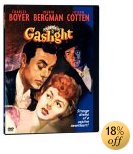Movies |
Gaslight
directed by George Cukor
By
Published: Jan 01, 2004
Category:
Drama
It’s happened to all of us — falling for the wrong man/woman and failing to realize our lover is a seriously bad character. Parents try to tell us. Friends intervene. We don’t listen — hey, we’re in love, we know this person, he/she is madly in love with us.
And then we find out.
If we’re lucky, the cost is a bruised heart and a healthy dose of self-doubt.
If we’re unlucky…we find ourselves having a hard time getting away from a mentally unbalanced stalker — or worse.
Butler rented “Gaslight” not long ago because he wanted to watch a movie about deception. About a very specific brand of deception — fooling a person who is smart and sophisticated and, by virtue of her brains, seemingly unavailable to a psychopath’s blandishments. But if this movie is any guide, the smarter and more sophisticated you are, the easier you are to fool.
George Cukor — Hollywood ‘s most accomplished “woman’s director” — was an ideal choice for the 1944 American version of “Gaslight.” (It had previously been made in Britain , and released in America as both “ Gaslight” and “ Angel Street .”) His first genius move was to cast Ingrid Bergman as the fragile victim. His second was more radical — he took Charles Boyer, usually cast as a hero, and made him the sinister seducer.
The plot is a simple melodrama, as dated as Ovaltine. A London woman is killed for her jewels, but the killer doesn’t get them all. Years later, that woman’s niece — a fledgling opera singer, played by Bergman — meets a mysterious man (Boyer) who falls in love with her. She cannot resist him. They marry, and, in short order, move to the London house which she inherited from her murdered aunt.
Now begins the really fun stuff. Although Bergman is beautiful and rich and social, Boyer needs to isolate her from her world so he can search for the missing jewels without interference. His tricks seem obvious. The gas lights in the house, for example, suddenly dim and brighten again; when Bergman notices, Boyer assures her there’s nothing wrong — thus the phrase you sometimes hear, “to gaslight.” There’s a piece of “missing” jewelry. And a “lost” glove. Soon enough, Bergman is “ill.” Later, she will worry that she is “insane.” And then looms the ultimate fear: her husband will have her committed.
There has to be a Gallant Man: here he is Joseph Cotton. And a flirty little tart: 17-year-old Angela Lansbury, making her screen debut and quite effectively batting her lashes at Boyer. And, after a Tense Confrontation, a Happy Ending.
“Gaslight” was nominated for a total of seven Academy Awards, including Best Picture, Best Actor (Charles Boyer), Best Supporting Actress (Angela Lansbury) and Best Original Screenplay. It won two: Bergman as Best Actress and Best Black/White Art Direction.
Our world comes in vivid color, and so artfully wrapped for our delectation it’s hard to know what’s real. If you’re like Butler , you sometimes feel you’re always being “sold.” That is why it’s a thrill to slip in a DVD and return to a black-and-white world of rich London , and great costumes, and beautiful drawing rooms — and a villain who seems a great deal slicker than some of the ones now selling themselves to us.
To buy “Gaslight” from Amazon.com, click here.


